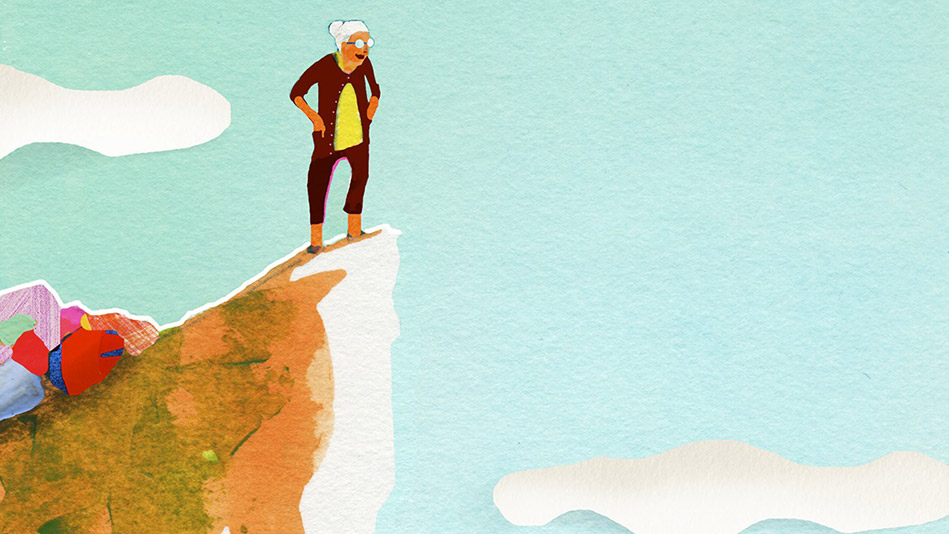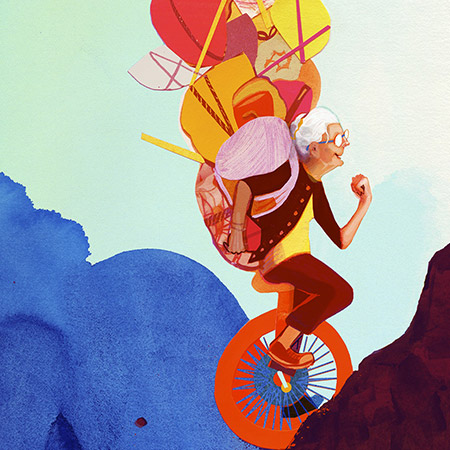This Is the Best Thing About Getting Older
Embracing the feisty, fearless old lady within.

Illustrations by Julia Breckenreid
Many years ago when I was going through a dark season of depression and self-loathing, I taped a sweet photograph of myself at the tender age of 2 on my bathroom mirror. Looking at that photo every day reminded me that I once was this blameless little person, deserving of all tenderness—and that part of me would always be this blameless little person deserving of all tenderness. Meditating upon a smaller and more innocent version of my face helped me learn to be more compassionate to myself. I was finally able to recognize that any harm I inflicted on me, I was also inflicting on her. And that little kid clearly didn't deserve to be harmed.
Reconnecting with one's inner child is a terrific therapeutic practice, whether you have old wounds to heal or simply want to avoid opening up new ones.
These days, however, I find I'm not so interested in my inner child. Instead, I have become absolutely fixated upon channeling my "inner crone"—the badass old lady who already dwells somewhere deep within me and whom I hope to fully become someday.
I recently tucked away the photo of my adorable 2-year-old self and replaced it with a photo of my favorite and most inspiring true-life crone—an elderly but sturdy Ukrainian babushka named Hanna Zavorotnya, who has a face like boiled pierogi and lives in Chernobyl. Yes, that Chernobyl.
Thirty years ago, when the nearby nuclear reactor blew up, Hanna's town became unlivable, even deadly. (And so it will remain for centuries.) The entire population was evacuated and sent to soul-crushing government housing in other cities. But as time passed, a small handful of tough peasants defiantly sneaked back to their contaminated ancestral homeland, where they have been thriving now for years. Most are in their 70s and 80s. Most—like Hanna, my human spirit animal—are women.

You know why Hanna wants to live in Chernobyl? Because she likes it there. It's home. Is it safe? Of course not. It's some of the most dangerous land on earth. But to a lady like Hanna, who has already been through so many trials (famine, World War II, an atomic meltdown, aging itself), what does safe even mean anymore? So Hanna drinks the contaminated water, plants vegetable gardens in the poisoned soil, makes her own moonshine, laughs about life, and then goes outside to butcher another radioactive pig to make radioactive sausage. She is joined by her friends, who live and laugh and butcher their own irradiated pigs.
And get this: These fearless babushkas of Chernobyl are outliving their compatriots who stayed behind in the "safe" and "nontoxic" cities.
Why are these tough old crones thriving? Because they are happy.
And why are they happy? Because they do exactly what they want.
I'd really like to do that.
Some might consider the word crone derogatory. I don't. The crone is an ancient and formidable character in myth and folklore. She's the bearer of great wisdom. Even when blind, she manages to possess supernatural vision. She is often a guardian of the underworld because she has no fear of death—which means, of course, she has no fear of anything.
We live in a society that fetishizes youth. In fact, we live in a culture where staying young is considered a real accomplishment. But I'm losing interest (if I ever had any at all) in being forever 21.
Of course I still have an inner child. I always will. But these days, when my inner child starts feeling insecure or terrified of the world, I just ask myself, WWMICD? What would my inner crone do?
Then that beautiful old being rises up, fixes me with her fearless, cloudy gaze, and says the same powerful word every time: "Live."
Elizabeth Gilbert is the author of, most recently, City of Girls: A Novel(Riverhead, 2019).
Reconnecting with one's inner child is a terrific therapeutic practice, whether you have old wounds to heal or simply want to avoid opening up new ones.
These days, however, I find I'm not so interested in my inner child. Instead, I have become absolutely fixated upon channeling my "inner crone"—the badass old lady who already dwells somewhere deep within me and whom I hope to fully become someday.
I recently tucked away the photo of my adorable 2-year-old self and replaced it with a photo of my favorite and most inspiring true-life crone—an elderly but sturdy Ukrainian babushka named Hanna Zavorotnya, who has a face like boiled pierogi and lives in Chernobyl. Yes, that Chernobyl.
Thirty years ago, when the nearby nuclear reactor blew up, Hanna's town became unlivable, even deadly. (And so it will remain for centuries.) The entire population was evacuated and sent to soul-crushing government housing in other cities. But as time passed, a small handful of tough peasants defiantly sneaked back to their contaminated ancestral homeland, where they have been thriving now for years. Most are in their 70s and 80s. Most—like Hanna, my human spirit animal—are women.

You know why Hanna wants to live in Chernobyl? Because she likes it there. It's home. Is it safe? Of course not. It's some of the most dangerous land on earth. But to a lady like Hanna, who has already been through so many trials (famine, World War II, an atomic meltdown, aging itself), what does safe even mean anymore? So Hanna drinks the contaminated water, plants vegetable gardens in the poisoned soil, makes her own moonshine, laughs about life, and then goes outside to butcher another radioactive pig to make radioactive sausage. She is joined by her friends, who live and laugh and butcher their own irradiated pigs.
And get this: These fearless babushkas of Chernobyl are outliving their compatriots who stayed behind in the "safe" and "nontoxic" cities.
Why are these tough old crones thriving? Because they are happy.
And why are they happy? Because they do exactly what they want.
I'd really like to do that.
Some might consider the word crone derogatory. I don't. The crone is an ancient and formidable character in myth and folklore. She's the bearer of great wisdom. Even when blind, she manages to possess supernatural vision. She is often a guardian of the underworld because she has no fear of death—which means, of course, she has no fear of anything.
We live in a society that fetishizes youth. In fact, we live in a culture where staying young is considered a real accomplishment. But I'm losing interest (if I ever had any at all) in being forever 21.
Of course I still have an inner child. I always will. But these days, when my inner child starts feeling insecure or terrified of the world, I just ask myself, WWMICD? What would my inner crone do?
Then that beautiful old being rises up, fixes me with her fearless, cloudy gaze, and says the same powerful word every time: "Live."
Elizabeth Gilbert is the author of, most recently, City of Girls: A Novel(Riverhead, 2019).



